First, if you want to see me shudder in disgust, don’t miss minute 4:05 in the video tutorial
And Friends, perhaps you’ve seen these gorgeous moths frolicking in your garden, though I hope you haven’t.
The Squash Vine Borer (Melitta curcurbitae) is a great moth to become familiar with because yes, they’re beautiful. Also, they’re one of the most devastating insects in your garden.
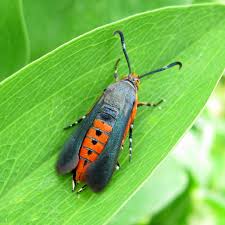
The gorgeous and devastating adult moth of the Squash Vine Borer.
Squash Vine Borers make their home in the base of your squash plants, devouring their soft marrow before killing their host. They’re particularly fond of any Cucurbita pepo plant, which includes all manner of zucchini, summer and pattypan squash in addition to pumpkins, acorn, spaghetti, delicata squash and more.
Thankfully they are not attracted to cucumbers and melons, but most squash, winter squash, and pumpkins can be dramatically affected. I’ve heard and seen horror stories of home gardens decimated by them my entire life. Here’s how to keep them at bay.
Squash Vine Borer Life cycle
Rumi says, love your enemy.
My mother says, know your enemy.
I say you decide!
Either way, understanding the lifecycles of insects and diseases in your garden is key to preventing and managing problems organically in your garden.
On our farm in the Finger Lakes, squash vine borer adults emerge from their underground cocoons in early July. Though they fly, they strongly prefer to stay close to home. Individual eggs are laid at the base of their preferred host plants (Cucurbita pepo and C. maxima, more on that later) and one week later, the larvae ‘bore’ into the stems and proceed with an all-you-can-eat attitude, hollowing out your squash stem in four to six weeks before burying themselves in the soil to emerge as an adult the following year. This lifecycle awareness is the foundation of the organic management strategy. But first!
Squash Vine Borer Damage
If you see wilting leaves on your squash, you likely have squash vine borers. It’s subtle at first, only notable in the heat of the day when you might expect plants to wilt, but soon the plants will die. To see if you have dry plants or infected plants, investigate your stem, right at the base where it meets the soil. If you see holes and/or moist greenish/orange frass (the hilariously technical term for insect poop), you’ve got a squash vine borer.
Here is a vine just beginning to show signs of the marauding larvae:
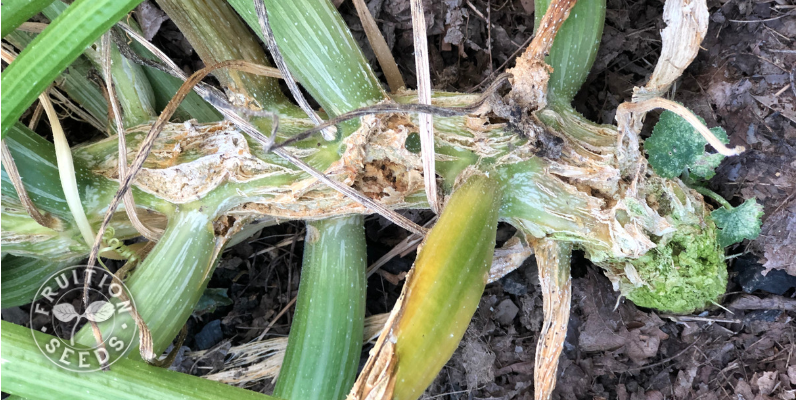
Here is a very dramatic example of damage, unchecked:
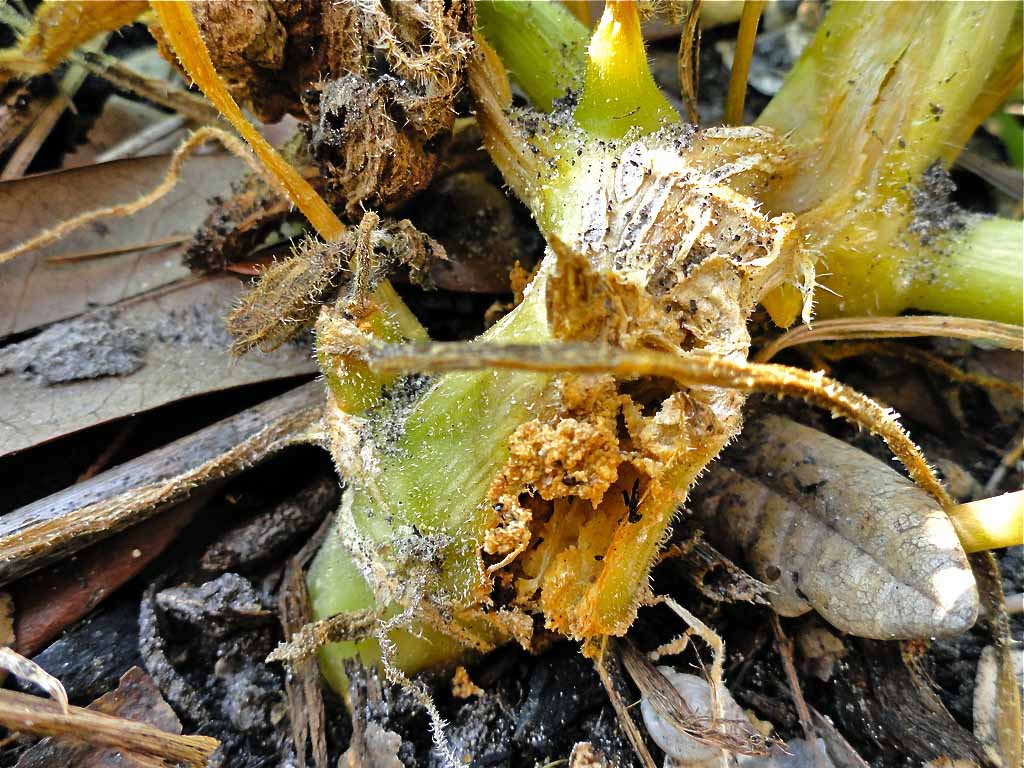
And here is squash vine borer devouring a squash stem, just before it climbs out and pupates in the soil and overwinters to return next season:
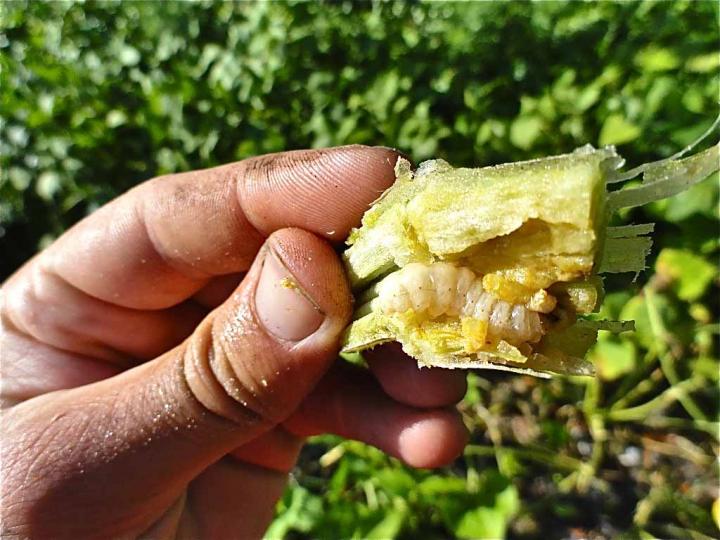
Squash Vine Borer Management
Squash vine borers are challenging to manage, though far from impossible.
Once the larvae enter your squash, the most proactive approach is to pull affected plants and kill the larvae.
As with so many things, prevention is the best cure.
Here are the four best ways to outsmart the squash vine borer:
1) Catch the adult moth! They’re pretty easy to see: They’re an inch long, gorgeous and nothing else looks quite like them. You’ll often hear their buzzing wings before you turn your head to see them, as well. If you’re a Jedi, swap them between your palms. Otherwise, know they are attracted to the color yellow (like the flowers of the host plants…!) and if you fill a yellow beach pail with water, they’ll often drown themselves.
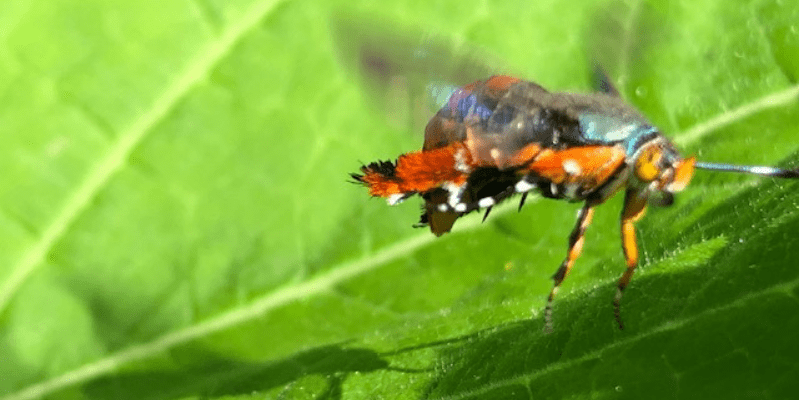
Bija, a member of Fruition’s Flourish Garden Club, snapped this shot of the adult Squash Vine Borer in action.
2) Catch the grub! Once you see that dramatic damage at the base of your squash plant, dive in and dig around for the fat white-ish grub who is devouring the marrow. It grows every day, finally pupating at about two inches long. If you don’t find it, burn the whole plant. I know it’s dramatic. But you really don’t want to let them live to plague you more and more. Sigh.
3) Starve them out! How? Grow varieties whose genus species are Curcurbita moschata rather than pepo or maxima. Varieties of moschata have dense stems the borers can’t ‘bore’ into, while pepo and maxima are succulent and sappy, easy for the larvae to bore into.
The bad news: Classic zucchini, summer squash, patty pans as well as pumpkins, acorn, delicata, spaghetti, and buttercup are not moschata.
The good news: You’ve still got options! Butternut, long island cheese (our variety ‘Gouda,’ developed by Michael Mazourek at Cornell, is an awesome refinement of long island cheese-style pumpkins) and tromboncino squash are all moschatas. Our favorite moschata of all time is Honeynut (below), Cornell’s super small and super sweet butternut with a built-in ripeness indicator, making it easy to know when to harvest.
More good news: You can eat winter squash as summer squash. (Young tromboncinos especially are excellent green on the grill.) Even if you have a significant population of squash vine borers, after three years of being ‘starved’ out of your garden they will move on.
Only squash of Cucurbita moschata, like Cornell’s Honeynut, have vines dense enough to starve and dissuade the Squash Vine Borer.
4) Plant Late! Late sowings of summer squash in early July will mature after adult borers have laid their eggs, thwarting their lifecycle.
Organic gardening focuses on comprehensive soil and plant health as well as preventive measures, so we’re addressing root causes and not dependent on band-aids. With these four keys, it’s easy to prevent squash vine borer populations from building over the years as well as reduce them once they’ve become a serious issue.
You’ll also find Squash Bugs adorning your plants, often by the hundreds. And then thousands. You’ll find more of their story, lifecycle, damage, and management here.
Sow Seeds & Sing Songs,

and the Many Beings of Fruition
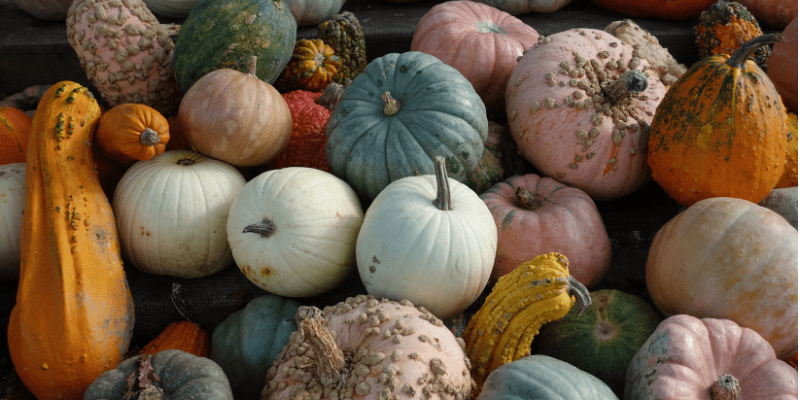
Who knew Latin names would actually make your life more abundant?!

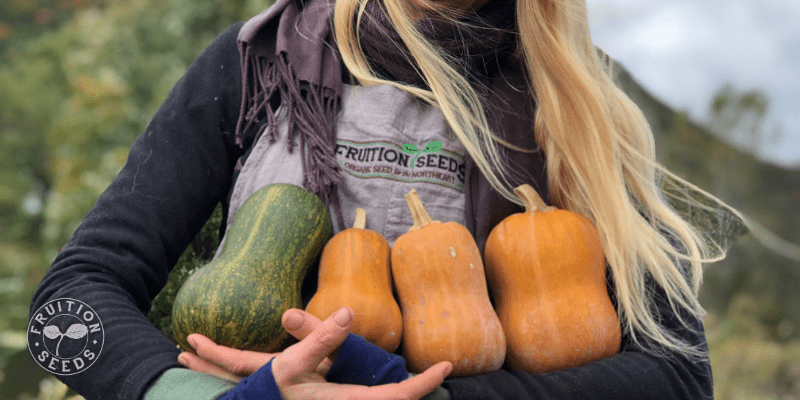
Great video on the vine borer! I have battled these guys for years in southern New Jersey. I have to admit, I do have some Jedi skills in killing the moths BY HAND! I have also cut open vines and happily squished the grubs. I have even smashed cocoons found in the soil. But between the borers and squash bugs, I haven’t even been planting squash or zucchini at all the past couple years. This season I got a 30 cent packet of yellow squash seeds from the dollar store, so I planted them in early July thinking the borer danger was over. So my plants were growing great and I have harvested a few squash. But much to my surprise and dismay, I have had two sightings of vine borers over the past two weeks. WHY?!!! I thought their season was over by now. I was so shocked I missed out on squishing the moth(s). Maybe it was the same one? I can only hope. So I probably should rip out these plants and see if I can eradicate the worm(s). Sigh.
Oh no! So sorry to hear of your struggle with squash vine borer 🙁 I don’t doubt your moth and grub squishing skills and I am sure that it is making a difference. Your best bet is to simply stay away from cucurbits for two seasons as devastating as it is, this will hopefully starve out the squash vine borer populations that exist in your garden. Best of luck and don’t hesitate to reach out ANYTIME! -Heather & The Fruition Crew
Please read this. Many years ago when I gardened in Middle Tennessee I was known for beating my squash plant to death in the madness of squash vine borers exterminating my beautiful squash plants. Word got around and someone told me in the future when you put the squash seed into the ground add the seed for a white icicle radish alongside. Seriously. Do not pull pull the radish from the ground. It will get big and a tad ugly but your squash will grow healthy. It must be planted the same day you plant the squash seed. It works, I have been doing this for years!!
Bonnie, when you say put the radish seed in alongside — is there any spacing between the seeds or just put them in the same planting hole? thanks!
Very informative video but really struggled to hear you. Is it possible to wear a mike?
Hi Tracey,
We have started to wear a mic to help with audio quality!
I look for infestation early and do surgery to find and kill the squash borers in the vine. The plants survive and continue to produce. Cuts parallel to the direction of growth doesn’t seem to damage the vine. I have also tried planting late with some success. Thanks
This year, I tried something I saw while visiting my son in North Carolina. It was in their Master Gardener’s Display garden in Wilmington. They had wrapped the squash stems in cotton gauze. So far this year, I haven’t had any problems. Now with that said, we’ll see what happens from here on in! Will report back to let you know what the results are at the end of the season!
I wrapped my stems in aluminum foil last year. worked wonders! Gauze seems easier…I might do both!
Terrific information. It’ll help, for sure.
I have had some luck painting the lower stems with slush consistency clay. Just have to repaint after heavy rain.
Squash vine borer damage can also be prevented before it starts for the winter squashes (butternut/acorn/delicata/pumpkins). Eggs are planted at the “nodes” of the plants, the place where the leaves & flowers emerge. Cover every other or 3rd node with dirt and no eggs will be planted there and roots will grow from the node so if a borer larva does get into the vine at an uncovered node the part of the plant past there that happens will still survive. I’ve done this for years.
We live in the Ozarks with a long growing season. There’s a lot to do on a farm and we’ve compromised by using Pyrethrin for summer squash and sometimes Permethrin for our winter squash(which works very well but is not appropriate for certified organic). I could probably plant a later crop around July 1st, but at that point it is harvest season for blueberries and we just run out of time.
I’ve got one vine that I may have managed to save on my pumpkins, although I’m sure it won’t grow into the “Atlantic Giant” name. Should I pull up all of the other vines in the patch and destroy them? And is there anything specific to do after the season is over that will thwart any overwintering vine borers?
I’m spraying squash stems with BT and dusting with diatomaceous earth. That, along with daily inspection of the undersides of leaves for eggs seems to be having good effects. Not perfect, a few vine borers have gotten through. My surgical removal skills aren’t great. I cut but often can’t find the grub!
I check constantly, although I sometimes miss them. I usually use a razor or sharp knife to slice along the length on one side and pry open to look for grubs and kill them. You want to farther than you think is necessary. Then pile plenty of soil on the section you cut.
I’ve will also mound soil over a few short sections of the vine as it grows. The thought is, it will send out roots in those areas to bring in water and nutrients, giving you some insurance.
Lots of great, helpful information here, but I have a problem with squash vine borers boring directly into my squash fruit, rather than the vines! I grow only cucurbita moschata, and I always think I’m safe because the vines never suffer damage, but inevitably they always end up destroy a squash fruit or two even though I try to be really vigilant and keep the squash up off the ground. Any suggestions to specifically keep the fruit safe?
Enjoyed the informative video. A few things I believe have reduced difficulty with squash vine borers: afraid I’d miss some in the damaged stems, I put the pulled stems on my gas grill and “cooked them” until they were dried and safe for the compost pile. Also, looked for and stomped on unearthed pupae in the spring. Growing the Italian heirloom zucchini Costata Romanesco is helpful because it has tough stems that survive some damage.
Ted from new England Seed.
I cover my plants at the time of seeding with fine mesh(ie tobacco cloth ) until the plant start to flower. Then I remove(this week 7/17) it to let the bees pollinate.
I have had great success doing this
Hi Ted, Thanks for sharing your success with us! <3 Melissa
After 2 days of rain I went out to look at my very small garden. I did have a trellis for my cucumbers. Much to my surprise I saw about 8 ends of the cuks were all wilted. So I started looking for something that might have caused this. I came across holes in the stems. I slit it open and found these little light green worms. I cut off all of the wilted stems and sprayed with Neem. That helped for awhile. Then I started seeing these red and black bugs, I would just fold up the leave and kill it. Which came first?
I have been growing cucumbers for years and never had any problems.
My garden is above ground. Everything was doing well and then this heat hit. My 2 tomatoe plants were growing up but then the leaves turned yellow and brown and the tomatoes looked like golf ball and all split.
Any advice?
Hi Nan, Thanks for asking. from what you are describing as little light green warms) could be cabbage loopers. It is hard to say which came first. It is hard to say happed with your tomatoes without pictures. We recommend checking out our blog Identifying & Managing Tomato Disease Organically
The SVB moth here in NJ lay eggs on any spot of the plants. The leaves, tendrils, sides of leaf veins, the fruit, the flowers, all parts of stem, tops and bottoms of leaves. I’ve wrapped stems all the way with foil, gauze, medical tape, strong essential oils, BT injections and sprays, diatomaceous earth, cinnamon and hot pepper, planted icicle radishes, rotating to a different area, tried timing later in season, squishing the chrysalis, eggs and moths, done surgery numerous times on plants while reburying stems, set up yellow soapy traps, got pheromone traps, even resorted to real pesticides. Nothing works more than fraction! I’ve lost 95% of my curcubits every year!!! You would think I would learn and give up growing Pepo varieties but I just love my squashes! I’ve only had success the first couple years about a decade ago, and slight success throughout the years. I really don’t have any more info on methods that actually work. Can anyone give their experiences on treatments that have worked? I honestly think people have some success because their location isn’t as populated, my area is extremely infested I pick off at least dozens-hundreds of eggs a day!
I feel your pain. I have tried all the methods that you mentioned (except pesticides) and I too have not had any success. In desperation I didn’t plant squash for 3 years – I had SVB when I planted the 4th year.
Last year I moved to a 60 acre forested property that had never had a vegetable garden. SVB killed all of my zucchinis. I wasn’t on the lookout for them because I thought there was no way they would be in the area. Sigh…..
just found one of four healthy zucchini fully wilted, discovered that all four plants are infested. going to do some nighttime surgery to try to remedy this, thanks for this very informative post. all the best from philadelphia